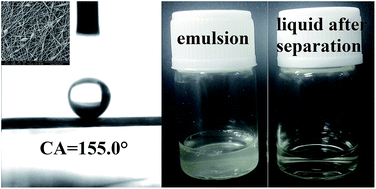Fibrous membranes electrospun from the suspension polymerization product of styrene and butyl acrylate for oil–water separation
Abstract
In this work, several polymers were synthesized via suspension polymerization when styrene and butyl acrylate were used as a rigid unit and a flexible unit, respectively, and the prepared polymers were then electrospun into fibrous membranes with good low-temperature flexibility. The obtained fibrous membranes had perfect hydrophobicity and lipophilicity, and their water contact angle approached 155.0° as the fibrous membranes were wetted by sunflower oil, thus the fibrous membranes possessed a good capability for separating oil from water. We researched the effect of initial oil content, extrusion rate, and the position of the oil–water interface on their oil–water separation capability, and the corresponding results showed that the maximum oil removal efficiency could reach 97.3%, and the oil removal efficiency was still up to 74.2% when the fibrous membrane was used for the seventh time. Additionally, the fibrous membranes could make the O/W emulsion clear via oil absorption from water. In addition, we also investigated the other aspects of the fibrous membranes through the corresponding instruments.


 Please wait while we load your content...
Please wait while we load your content...